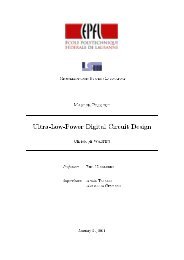Design and Realization of a Prototype Hardware Platform for ...
Design and Realization of a Prototype Hardware Platform for ...
Design and Realization of a Prototype Hardware Platform for ...
Create successful ePaper yourself
Turn your PDF publications into a flip-book with our unique Google optimized e-Paper software.
The MegaWatch Wireless <strong>Plat<strong>for</strong>m</strong>Master's Thesis - Emanuel Corthay6 The MegaWatch <strong>Hardware</strong> <strong>Plat<strong>for</strong>m</strong> <strong>Design</strong>Each block is linked to the other via a bus. The two bus specifications are the result <strong>of</strong> team workamong students doing related projects at LAP. They are available on the MegaWatch website at[13] <strong>and</strong> [14].The Wireless LAN uses a st<strong>and</strong>ard Compact Flash (similar to PCMCIA) connector, <strong>and</strong> the RF isdirectly piggy-backed to the extension board.The processor unit used in this project is a revision <strong>of</strong> Cédric Gaudin’s original diploma work, theRokEPXA board. The RF <strong>and</strong> WiFi block are <strong>of</strong>f-the-shelf commercial products that we interfacedthrough the extension board to the system. The MegaWatch board has been entirely designed<strong>and</strong> built during this project. The power supply board is also an original work, but conducted jointlywith Cédric Gaudin.6.3 Main Processor Board6.3.1 IntroductionThe main board contains the heart <strong>of</strong> the system. It’s where the various data coming from theperipherals are analyzed <strong>and</strong> used according to a piece <strong>of</strong> s<strong>of</strong>tware that runs on a microprocessor.The s<strong>of</strong>tware can be st<strong>and</strong> alone or integrated within an operating system (OS). In the first case, itis compiled <strong>for</strong> the given processor or microcontroller architecture into fundamental instructionsexecuted sequentially. The developer must take care <strong>of</strong> everything. Moreover, having twodifferent applications running concurrently is not an easy task.By contrast, it can also be integrated within an OS. For more complex, integrated applications, theOS version is preferred, because a lot <strong>of</strong> features are made available to the developer throughst<strong>and</strong>ard, portable functions <strong>of</strong> the operating system.On embedded devices like the MegaWatch units, the available space, computational power <strong>and</strong>memory is a scarce resource. Thus, the OS <strong>and</strong> processor must be carefully chosen toaccommodate these special needs <strong>and</strong> use the available hardware as efficiently as possible. Atthe same time, the development must be as easy as possible <strong>for</strong> the developer.Another important thing to consider is the interface, or how to connect a given device to theprocessor. For advanced <strong>and</strong> wide-spread peripherals like memory, st<strong>and</strong>ard system bus definingthe electrical way to connect such a device to a processor exists. Examples include SDRAM, PCI,PCMCIA <strong>and</strong> CompactFlash. Most commercial processors then implement the bus directly on theprocessor through a certain number <strong>of</strong> specialized connections (referred to as PINs later in thisdocument), <strong>and</strong> include the associated controller on the chip. For less dem<strong>and</strong>ing peripherals,st<strong>and</strong>ard serial controllers <strong>for</strong> RS-232, I 2 C or SPI buses are usually integrated on most embeddedprocessors. That’s because they are very common <strong>for</strong> small peripherals like sensors, ADC <strong>and</strong>motors, or simply to communicate with a st<strong>and</strong>ard PC.This sounds like a very promising interface, but requires fairly complex peripherals with a controller<strong>for</strong> the given bus. At the same time, such a peripheral is usually composed <strong>of</strong> a monolithic, staticchip known as ASIC (Application-Specific Integrated Circuit). The advantage <strong>of</strong> these dedicatedchips is their low cost due to high volume manufacturing, <strong>and</strong> high speed, because the logic on thechip is dedicated to a certain task. On the other h<strong>and</strong>, if the features <strong>of</strong>fered do not meet therequirements <strong>for</strong> a system, there is no way to change them. That’s where an intermediate,reprogrammable solution comes into the picture. One such solution is an FPGA, or FieldProgrammable Gate Array. It not only <strong>of</strong>fers a flexible, custom interface solution, but can alsoimplement various programmable functions, as illustrated in figure 10.25 / 83















